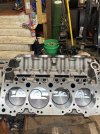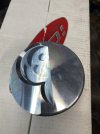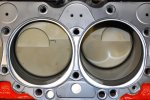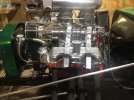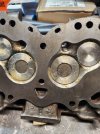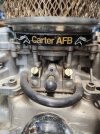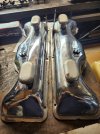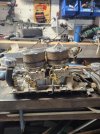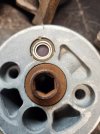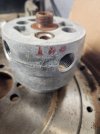Those appear to be Icon pistons.As such,they come in 2 types,one for the stock 6.10 rod,the other for the 6.135 length 348,big block rod.Both are rated at 9.9-1 in a car blok,when assembled at a quench of .040,and using a 16cc head.Most Icons are in the 25-30 down range as delivered,otherwise are very good parts.TO get 10 plus compression,mill the block .035,use an .040 head gasket,and run a set Bob Walla heads[5cc].The 333 head is a small port head and not necessarily what you want for a race engine,esp.if you want to run 2-4 bbl carbs.
You are using an out of date browser. It may not display this or other websites correctly.
You should upgrade or use an alternative browser.
You should upgrade or use an alternative browser.
409 race engine
- Thread starter Gary C
- Start date
I'd make sure what I had for rods and pistons before I did anything. That combo is just missing something which I think is the proper rod. Those pistons shouldn't be that far down with the proper stuff. Just my thoughts.
Does your block have any vin # or assembly date stamp? It may not if it is a service block. Does it appear to have been decked? I am doing a build with some IC959 Icon pistons, stock 409 crank & 409, 6.010 length rods. I decked a virgin block .025. By the calculator & CAD the piston quench pad will be flush / 0 deck. A 8007 Fel Pro head gasket will get me .042/.045 quench. Judging by the shape of the valve pockets and the shape of the pin boss, I don't think these are Icon pistons. I am comparing your pistons to the Icons I have here. Typically there will be an identifying part/job number or manufacturer logo on them. If your block has a virgin deck cut the .030 off and get the piston flush. Or cut it less and use a thinner Cometic gasket. Either way the piston needs to end up .040/.045 from whacking the head at TDC.
Jeff
Jeff
Last edited:
The valve reliefs don't resemble the ones on my Icon 348 stroker pistons either,according to Icons website they illustrate the 348 and 409 pistons using the same style VR. Let us know how close the actual quench distance turns out to be compared to the calculations, curious about how close actual block deck heights are to the OEM specifications.Does your block have any vin # or assembly date stamp? It may not if it is a service block. Does it appear to have been decked? I am doing a build with some IC959 Icon pistons, stock 409 crank & 409, 6.010 length rods. I decked a virgin block .025. By the calculator & CAD the piston quench pad will be flush / 0 deck. A 8007 Fel Pro head gasket will get me .042/.045 quench. Judging by the shape of the valve pockets and the shape of the pin boss, I don't think these are Icon pistons. I am comparing your pistons to the Icons I have here. Typically there will be an identifying part/job number or manufacturer logo on them. If your block has a virgin deck cut the .030 off and get the piston flush. Or cut it less and use a thinner Cometic gasket. Either way the piston needs to end up .040/.045 from whacking the head at TDC.
Jeff
Valve pockets do not match Icons that I can see. Pictured Icons & the ones I have here have a 180° + valve pocket. Gary C's are a fat 90° pocket.
A stock block will measure approximately 9.815 when measuring perpendicular from the deck to the center of the crank. Like one would measure a normal 90° deck block.
Jeff
A stock block will measure approximately 9.815 when measuring perpendicular from the deck to the center of the crank. Like one would measure a normal 90° deck block.
Jeff
Skip FIx
Well Known Member
Man those are some deep valve notches! Either for a big cam or high compression.
Thread where I CC'd everything on mine and the JE piston pictures with barely a exhaust notch.
 www.348-409.com
www.348-409.com
Thread where I CC'd everything on mine and the JE piston pictures with barely a exhaust notch.
Block,piston nothc CCs | 348 and 409 Engines
Dome .350, CH 1.215(6.385 rod 4" stroke). The intake notch is listed as .001 and the exhaust .350 but no diameters listed. 690 gms.
Attachments
Scott the picture is not at tdc. look at the 2 center pistons. they are off set. At tdc they would be even.I'd make sure what I had for rods and pistons before I did anything. That combo is just missing something which I think is the proper rod. Those pistons shouldn't be that far down with the proper stuff. Just my thoughts.
30 in the hole, with a stock deck would not surprise me. Also depends of if the measurement was done in the right place and right method. Should be done at the top of the piston, twice. Once piston rocked up then rocked down. Subtract the 2 measurements. his is in the hole measurement. Put it at tdc and re CC is the only to know. If cc'ed correctly you don't need use the in the hole measurement. Mack sure to seal the piston cylinder gap (grease) so you don't loose any fluid.The engine builder checking it over says the pistons are 30 thou down from deck and he measured 85cc in combustion chamber and 25cc in head with 3.5 inch stock stroke.
Stroke won't matter if you have the right piston rod combo.
Correct, Russ. Being .030 in the hole will lower compression. If you need to take it apart, you can deck the block and use an .017 cometic gasket or a steel shim, which is about .019Those are not low compression pistons
Bob
On the plus side it would help "un shroud the valve/help flow". On the other hand it adds to "chamber" volume taking away from compression. Dyno testing would give answers.Why would the “lovin’” around the intake valve be needed? Is it in hopes of inducing more turbulence into the intake charge?
Jeff
Watching the carbon patterns on the piston and the head will tell if it helps.

